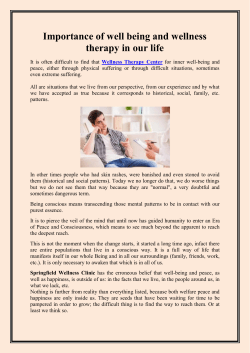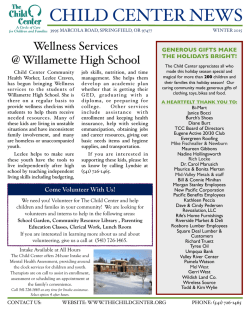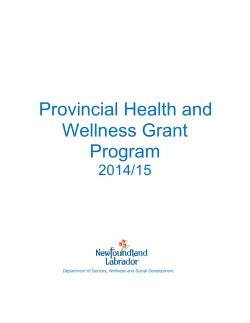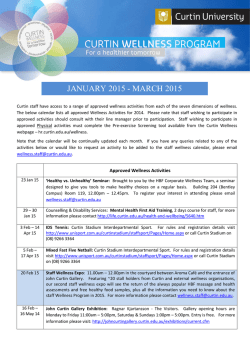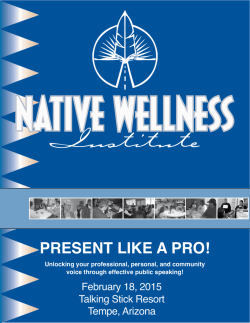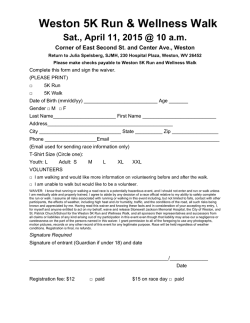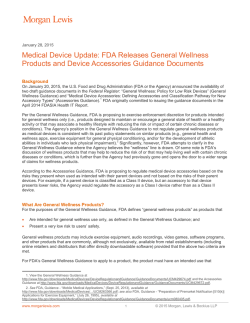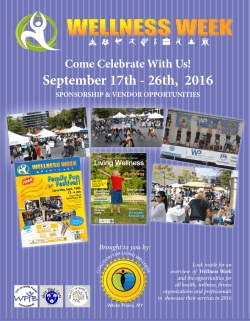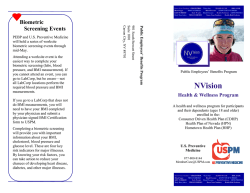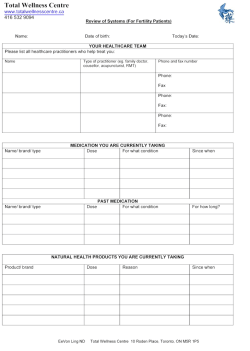
Linking Student Health Behaviors to the Practice of Prevention
Promoting Healthy Behaviors: Linking Student Health to Prevention Funded by The Robert Wood Johnson Foundation, 20022003. Research conducted by American Medical Student Association/Foundation in collaboration with Emory University “Healthy Doc-Healthy Patient” Project. Prepared by Lauren Oshman, MD, MPH American Medical Student Association/Foundation, 2003. 1 Purpose Examine how the practice of future primary care physicians is affected by prevention curricula taught in medical schools and your schools’ emphasis on medical student wellbeing. Learn how to foster collaboration of medical schools and student leadership on local and national level to facilitate adoption of exemplary programs to strengthen health promotion and prevention curricula. 2 Student Well Being Programs What the research shows 3 Are We Well in Medical School? Students’ health falters in medical school.1 – – Depression is related to poorer health habits.1 “Maladaptive behaviors” eventually form.2 – 1. 4 2. 3. 4. Alcohol consumption increases. Socialization and exercise decrease. Going to school when sick, self-prescribing and underuse of medical care. Residency can further erode wellness.3,4 Ball S, Bax A. Self-care in Medical Education: Effectiveness of Health-habits Interventions for First-year Medical Students. Acad Med 2002; 77(9): 911-917. Baldwin PJ. Young doctors’ health—II. Health and health behavior. Social Science & Medicine 1997; 45(1): 41-44. Collier V, McCue J, Markus A, Smith L. Stress in medical residency: status quo after a decade of reform. Annals of Internal Medicine 2002; 136(5): 384-390. Levey R. Sources of stress for residents and recommendation for programs to assist them. Acad Med 2001; 76(2): 142-150. What Do We Know About Wellness? 5 Being a primary care physician and having related healthy habits oneself predict one’s clinical practice of prevention. If medicine values disease prevention, and if physicians’ personal health practices are consistent predictors of prevention, we ought to cultivate healthy physicians in medical school.1 In order to give to others, physicians must have their basic wellness needs met. It is impossible to give what you don’t have.2 1. Frank, E, Rothenberg R, Lewis C; Belodoff B. Correlates of physicians’ prevention-related practices. Arch Fam Med 2000; 9: 359-367. 2. http://www.dev.kcom.edu/student/stillwell/home.htm The state of health promotion programs for students 6 Only 20% of allopathic and osteopathic medical schools provide wellness programs for their students. 24% of schools offered health promotion programs in 1988. Hooper J, Cox C, Cambre K, Wilburn D, Webster M, Wolf T. Comparison of the support allopathic and osteopathic medical school health promotion programs for students. The Science of Health Promotion. 1999; 13(3): 171-179. Student Wellness Programs Declining 150 125 100 75 50 44 55 27 25 Health promotion programs Accredited medical schools 0 1997 1993 1988 7 Cox CC, Cambre KM, Wolf TM, Webster MG, Hooper J. Trends in number and administrative characteristics of medical school health promotion programmes. Med Educ 2001; 35(2): 173-174. What do preclinical students think? 8 Wellness is linked to prevention: “...if we sacrifice our own health from studying too long, staying up too late, stressing out too much about exams we can’t take care of other people if we don’t watch our own health first.” Prevention should be integrated, not separated: “Nobody goes to those classes because they’re busy with the other ones…” Early clinical exposure is important: “In the clinics I’ve noticed … prevention being important but not in lectures.” Students want more prevention: “I can count the hours [of prevention education] on two hands … Miniscule would be the word.” AMSA Focus Group, 2002. What do clinical students think? Wellness is difficult to achieve: “We're really stressed, basically.” Clinical students see mentoring as important to wellness. “I [would like] having a designated person to whom students can turn at any time. That would be a hotline . . . A counselor.” Clinical experience is most useful in prevention: “observing physicians who have counseled for many years counsel a patient on a certain topic …” Specialty physicians have different opinions. “I'm going into surgical subspecialty … there is little role for prevention.” 9 AMSA Focus Group, 2002. What do Deans think about Wellness and Prevention? Our medical school discourages students from smoking Strongly agree Our medical school encourages students to exercise. Agree Neutral Our medical school encourages students’ healthy eating. Disagree Strongly disagree Our medical school has a good system to help students cope with stress. Our medical school encourages extracurricular activities that promote medical students’ health. 10 AMSA Survey of Deans, 2003. 0% 10 20 30 40 50 60 70 80 90 100 % % % % % % % % % % Who should promote healthy behaviors and prevention? In order to effectively encourage healthy patient lifestyles, physicians must adhere to one themselves. Primary care physicians need more training in prevention. Schools should encourage students/residents to practice healthy lifestyles. Faculty should set a good example by practicing a healthy lifestyle. 0% 11 AMSA Survey of Deans, 2003. 20% 40% 60% 80% 100% Do physicians have a responsibility to promote prevention with patients? 100 100 Percentage 80 60 60 40 Deans Students 31 20 8 1 1 0 Strongly agree 12 Agree Neutral Disagree Strongly Disagree Emory University, Healthy Doc Survey and AMSA Dean Survey data, 2002-2003. Making the Link Between Student Wellness and Prevention in Practice What others have done 13 Emory University Sample Curricular Interventions Pre-clinical 14 Medical Decision Making class used Healthy Doc survey data to learn about statistic (M1s); Physician panel on substance use (M2s); 1 hour talk in Behavioral Science on alcohol and tobacco use of physicians, U.S. medical students, and Emory 2003 medical students (M2s). The “Healthy Doc-Healthy Patient” Project is a 17 medical school study of and intervention in medical student health. Two-prong study being conducted at 16 US medical schools (2,000 students, 88% response rate) tracking the natural history of students’ attitudes and health and counseling behaviors and at Emory where an intervention to promote healthy student behavior was developed, implemented, and evaluated. Emory University Sample Curricular Interventions Clinical 15 Ethics/Psychiatry: Complete a Beck Depression Inventory and an alcohol CAGE screening questionnaire on themselves; Ethics/medicine: Completed an advanced directive and living will for themselves; Dermatology: Received information about skin cancer prevention and prevention strategies for themselves and their patients and a container of sunscreen for their own use. Emory University Sample Curricular Interventions 16 Healthy, quick-cooking class; Saturday visit to the mountains for hiking and healthy eating; Two wine-tasting seminars (student idea, attended by about 30 students each time) to teach about using alcohol for purposes other than inebriation; Weekly yoga classes. Kirksville COM Still Well Wellness Program Program Philosophy: “You are your own first patient.” “Wellness is considered the cornerstone for each student to model for future patients.” Still Well Wellness Program is a voluntary, comprehensive wellness program that encourages students to balance medical school with personal wellness. Participation: currently 73%. http://www.kcom.edu/student/stillwell/home.htm 17 Still Well Wellness Program: Seven Components of Wellness Emotional Vocational Spiritual Environmental Intellectual Social Physical 18 Still Well Wellness Program: Benefits Physical benefits Preparticipation physical examination. Six month fitness assessment. 2 hours free racquetball/week. Free aerobic classes. Other benefits 19 Year end recognition banquet. Quarterly wellness newsletter. Seminar series – diversity in medicine, interpersonal relationship building, stress management, high performance nutrition. Career benefits Pathways program in career planning that includes spouse. Academic benefits Extra points for participation in wellness seminar series in osteopathic manipulation. M2s do health exams for M1s. M2s create fitness and wellness Rx for M1s. Student committee plans exam schedule to allow student attendance at professional conferences. Still Well Wellness Program: Evaluation Results 20 Compared to a similar medical school cohort, both students in the Still Well Program and the control cohort had a drop-off in exercise and # leisure breaks taken up to Xmas break. After the break, Still Well participants restored their health habits to the original level, except for sleep deprivation and the intensity of exercise, while the control cohort had further declines in health habits. Still Well participants have lower levels of anxiety. Kirksville COM Prevention Curriculum Complete DOctor course – Commitment to student leadership – Leadership script documenting student volunteerism and leadership during and outside school for reference in residency application. Grading environment – – 21 Preclinical longitudinal course addressing prevention, wellness, clinical skills. Percentage grades in first two years. Pass/Fail grades in clinical rotations. Loma Linda University Wellness Program Alcohol, tobacco & drug use “Boundary items” for Adventists. Students pledge not to drink or smoke. Alcohol treatment and addiction support available. Mentorship Diet and exercise Counseling Student Assistance Program available for counseling. 22 Personal mentor for weekly meetings, friendship, and support. Reaches 40-70 students. State of the art fitness complex. Many extracurricular sports and activities. Vegetarian only cafeteria. Loma Linda University Curriculum: Ethics and Balance 1st year (20 hours) 23 Wholeness for Physicians – Stress management, relationships, controlling anger, and conflict resolution. – Required “Action Option Plan.” Orientation to religion and medicine - discussions on God and human suffering. Biomedical ethics. 2nd year Integration of religion and medicine – Integration of prayer and other treatment modalities into clinical context. Orientation Wellness Workshops University of Louisville 24 Week-long workshop during M1 orientation, 1981-2001. Goal: Medical students who practice constructive self-care will become role models for patients. Components: Environment, Communication, Mind/Body, Community, Ethics, Nutrition, Exercise, Recreation, Stress Reduction, Time Management, Relaxation, The Arts, Gender Issues, Relationships, Study Skills, Faith, Coping. Student Wellness Leadership UIC Wellness Consortium – – Creighton University Wellness Council – – 25 Participants plan wellness and health promotion activities each month. Activities include cholesterol & glucose screening, back safety & ergonomics, walking programs, etc. Elected medical student representatives. Participants plan wellness activities, meet with Dean, and plan lunch presentations. Data from assessment performed by American Network of Health Promoting Universities, a special project of the Association of Academic Health Centers, 2002. Role Modeling and Peer Support Programs Case Western Reserve University Wellness Elective1 Physician presenters role model coping strategies and stress reduction. Students perceived the elective to legitimize and give permission to self care and wellbeing. Talking with peers and “venting” was effective in stress reduction. Mercer 26 1. Personal Professionalism and Leadership mentorship program. Promotes student well being, health and wellness. Lee J, Graham A. Students’ perception of medical school stress and their evaluation of a wellness elective. Med Education 2001; 35(7): 652-659 Competency Assessment in Self Care Brown University Self awareness, self care, and personal growth are graduation requirements. Students may demonstrate self awareness by demonstrating competency in: medical interviewing class, Psychiatry clerkship, volunteer work, electives, or one-on-one meetings with student advisor. http://biomed.brown.edu/Medicine_Programs/MD2000/NineAbil.html 27 Sample Prevention Curricula What others have done 28 Do recent graduates believe adequate time is devoted to instruction of prevention? Health promotion and disease prevention – Screening for diseases – 8.5% inadequate, 90.3% appropriate, 1.2 % excessive. Infectious disease prevention – 29 16.9% inadequate, 81.6% appropriate, 1.6% excessive. 24.5% inadequate, 73.8% appropriate, 1.7% excessive. AAMC Graduation Questionnaire, 2002. Exposure to Community and Public Health Wayne State University Course based on ATPM competencies.1 “Clinical Learning Exercises” address public health learning objectives. University of Miami 30 12 week Primary Care clerkship incorporates lectures, small group cases, and CDC Healthy People screening software. Student placement in public health settings for one week. 1. Pomrehn, P., Davis, M., Chen, D., and Barker, W. Prevention for the 21st Century: Setting the context through Undergrauate Medical Education. Academic Medicine. 2000; 75 (7 Supplement): S5-S14. Use of Case-Based Learning and Technology University of Massachusetts The McQ’s, a simulated standardized family.1 Case-based modules address health promotion, lifestyle counseling, risk factor assessment, and preventive services. University of Kentucky 31 Computer-based patient management simulation simulates adult and pediatric preventive care visits for self-directed student learning exercise. 1. Pugnaire MP, Leong SL, Quirk ME, Mazor K, Gray JM. The standardized family: an innovation in primary care education at the University of Massachusetts. Acad Med 1999 Jan;74(1 Suppl):S90-7. What to do now 32 More medical schools should institute personal health promotion programs to improve student health. Medical schools should better integrate health promotion programs with clinical prevention curricula. Personal wellness may be a successful “hook” to interest medical students in prevention. What Can Students Do? Orientation Activities - Medical student survival week, tour of school wellness resources, panel discussion on surviving basic science classes. Seminars and Panel Discussion - Massage circle, prayer group, finger painting, pasta sculptures, drumming circle, Tai Chi, exercise/outdoor activities club, weekly yoga class. Student Wellness Activities – Panel on relationships in med. school, effective study habits, time management strategies, effects of sleep deprivation, spirituality and wellness discussion. 33 Peer Support Networks - Big sib/little sib program. Student-Dean Collaboration - Lunch with the Dean. Students Can Get Further Experience through AMSA 34 http://www.amsa.org/well/ Humanistic Medicine Action Committee Action Committee on Medical Education Humanistic Medicine Retreats LIGHT Rotation for Fourth Year Students Opportunities & curriculum through AMSA’s Complementary and Alternative Medicine project (http://www.amsa.org/humed/CAM/) Director of Student Programming ([email protected]) What Can Deans Do? “Let us emancipate the student, and give him time and opportunity for the cultivation of his mind, so that in his pupilage he shall not be a puppet in the hands of others, but rather a self-relying and reflecting being.” –Sir William Osler 35 Foster student initiated activities and support student leaders. Identify faculty leaders in prevention and wellness and provide support through faculty development.1 Provide institutional resources.2 Promote reporting and publishing of successful programs. 1. Sachdeva AK. Faculty development and support needed to integrate the learning of prevention in the curricula of medical schools. Acad Med 2000; 75(7): S35-S42. 2. AMSA Dean’s Survey, 2003.
© Copyright 2026
